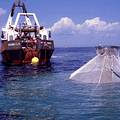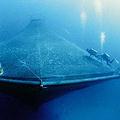 美國布希政府欲擴大聯邦所屬海域的養殖漁業規模,對此,參議院商業委員會6日展開公聽會討論。委員會雖支持該政策,但部分議員仍憂心其細部計劃不僅沒有保護環境的作用,也未保障國家漁業利益。此次召開的公聽會,是參議院針對布希政府希望未來10年內增加5倍養殖漁業規模的提案,所進行的第一次審查。
美國布希政府欲擴大聯邦所屬海域的養殖漁業規模,對此,參議院商業委員會6日展開公聽會討論。委員會雖支持該政策,但部分議員仍憂心其細部計劃不僅沒有保護環境的作用,也未保障國家漁業利益。此次召開的公聽會,是參議院針對布希政府希望未來10年內增加5倍養殖漁業規模的提案,所進行的第一次審查。
新罕布夏州共和黨參議員蘇努努(John Sununu)認為,擴張美國養殖漁業的壓力來自美國本土消費者。身為國家海洋政策研究委員會主席的蘇努努說:「美國消費者每年的海鮮消費量越來越高,這些增加的消耗量並不是來自野生魚,大部分都是來自美國環保法律管轄不到的海外養殖魚場。」
事實上,隨著全世界天然魚群的減少,養殖漁業在過去30年來已迅速發展,目前全球的食用魚有40%是來自養殖漁業。然而養殖魚場對環境可能造成很大的傷害──包括魚隻從養殖場逃脫、疾病以及水質等問題;批評者認為聯邦政府這項計畫過度重視開拓養殖漁業,卻沒有對保護環境做出應有的考量。
另一個令人憂心的主要問題是這些圈養魚群的食物來源。
美國「環境防衛」協會的生物學家戈德堡(Rebecca Goldberg)指出,一些最常被養殖肉食性魚類,如大比目魚、鮭魚和海鱺魚等,為了餵飽牠們,人們必須捕捉大量野生魚作為牠們的食物──餵食量遠高於這些肉食魚收獲量的2至4倍以上。
另外,加州民主黨參議員鮑克瑟(Barbara Boxer)注意到最近的研究已經在某些養殖鮭魚體內發現包括多氯聯苯等高度污染物。
鮑克瑟表示,這些發現以及其他常餵養養殖魚類以控制疾病傳播的抗生素、疫苗等問題,讓消費者對養殖魚類感到卻步。
不過,新罕布夏大學養殖漁業研究計畫主持人蘭甘(Richard Langa)則向委員會表示近海養殖漁業既非「正中紅心、解決問題的銀彈,但也非伺機發生的環境災難。」
曾以漁業營利且是牡蠣養殖者的蘭甘表示:「除了捕光海洋裡最後一條魚之外,應該要有其他選擇。養殖漁業必須留下來,問題是美國想不想站在自己養殖生產的這一方。但我們早就是養殖漁業的大宗消費者了,現在是決定我們要不要成為生產者的時候了。」
 The Bush administration's desire to expand aquaculture in federal waters drew support from the Senate Commerce Committee Thursday, but senators outlined concerns that the specific plan fails to safeguard the environment and lacks protection for state fishing interests. The hearing was the first look by the committee at the administration's proposal to increase fish farming five-fold over the next decade.
The Bush administration's desire to expand aquaculture in federal waters drew support from the Senate Commerce Committee Thursday, but senators outlined concerns that the specific plan fails to safeguard the environment and lacks protection for state fishing interests. The hearing was the first look by the committee at the administration's proposal to increase fish farming five-fold over the next decade.
The pressure to expand U.S. aquaculture is coming from American consumers, said Senator John Sununu, a New Hampshire Republican.
"American consumers are enjoying more seafood every year," said Sununu, chair of the committee's National Ocean Policy Study. "This increase in consumption is not coming from the wild and much of the increase is from overseas … from fish farms far from U.S. environmental regulations."
With wild fish populations declining across the world, fish farming has boomed in the past three decades and now supplies some 40 percent of the world's total food fish supply.
The potential for fish farms to harm the environment is high – concerns include escaped fish, disease and water quality – and critics say the plan is overly focused on expanding aquaculture without appropriate consideration of protecting the environment.
Another major worry is the composition of the feed for the penned fish.
The carnivorous fish most likely to be farmed – such as halibut, salmon and cobi – require some two to four times more wild fish to be caught for their feed than is ultimately harvested, said Rebecca Goldberg, a biologist with Environmental Defense.
Senator Barbara Boxer, a California Democrat, noted that recent studies have found high levels of contaminants – including PCBs – in some farmed salmon.
These findings, along with concerns about the antibiotics and vaccines often given to farmed fish to curb disease outbreaks, have many consumers wary about farm-raised fish, Boxer said.
Richard Langan, director of an aquaculture research program at the University of New Hampshire, told the committee that offshore aquaculture is neither a "silver bullet [nor] an environmental disaster waiting to happen."
"There has to be an alternative to hunting down the last fish in the ocean," said Langan, a former commercial fisherman and oyster farmer. "Aquaculture is here to stay. It is a matter as to whether the United States wants to be part of the production side of things. We have been pretty good job of being consumers of aquaculture products - now it is time to decide if we want to be producers."




